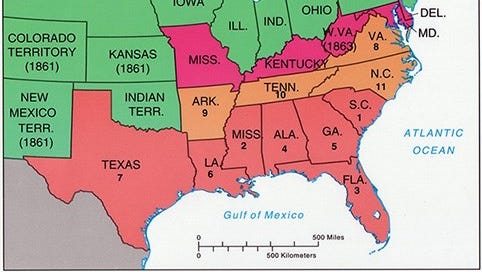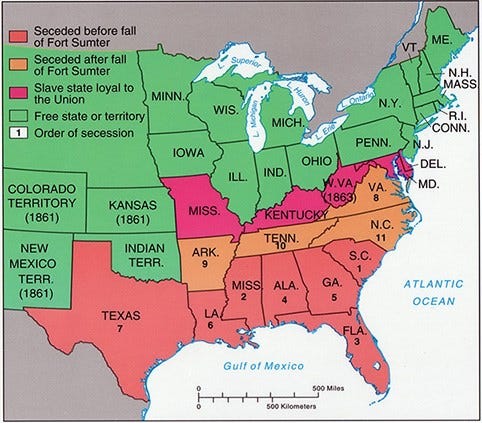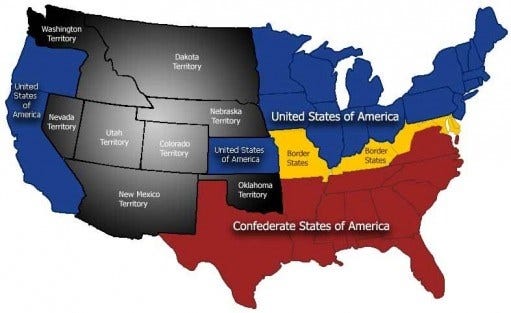Photo Credits: National Park Service
Issue #211 American History January 3, 2023
On January 3, 1861, just two weeks after South Carolina became the first state to secede from the Union, the state of Delaware rejects a similar proposal.
Wait! Delaware? Joe Biden’s Delaware?
Yes, although Delaware was the first state to ratify the United States Constitution in 1787, it was also considered a “slave state” because slavery was still legal in that state. About 1,800 of the 20,000 Black people living in Delaware at that time were enslaved, primarily in Sussex County, the southernmost county in Delaware.
However, although there were some Southern sympathizers in the Delaware legislature, the majority of the lawmakers and the governor were “Unionists.” So on January 3, 1861, the Delaware legislature voted overwhelmingly to remain with the United States.
Over the next several weeks after Delaware and the other northern states voted to stay with the Union, six more southern states joined South Carolina in seceding from the Union. After the South captured Fort Sumpter in South Carolina on April 12, 1861, four more states seceded, and joined the other states that had formed the Confederate States of America on February 4, 1861.
Abraham Lincoln was elected President of the United States in November 1860, although he lost in all of the southern states. Lincoln was inaugurated in March 1861. His election caused the southern states to believe that their way of life involving white supremacy and legal slavery would come to an end.
Today’s post continues below.
No intrusive ads or annoying popups ever! Instead, please see the important information below and at the bottom of this post. That’s how we grow and sustain this publication. AND, please keep those “Likes” and comments coming! Thanks!
There is new lower pricing for the paid levels!
Paid subscribers with the Substack app are invited to participate in the W.A.S. Chat Room to discuss today’s post.
All posts are free for fifteen days after their publication. To read all older posts, including the complete archive, and to support us financially, please consider upgrading your subscription to a paid level. Save 17% with an annual subscription. Thank you for your support!
Today’s Post Continues:
By the 1850s, the North, which supported a strong federal government, was becoming more industrial and was dedicated to utilizing free labor and immigration. A growing abolitionist movement was demanding freedom for all people.
By the 1850s, the economy of the South was an agricultural one dependent on cotton, tobacco, and slave labor. They favored a federal government that allowed the states to make their own rules and believed that the North was trying to destroy their Southern culture and heritage.
The North wanted the western territories to be open for small farmers to work the land and buy their goods from the companies in the North.
The South wanted to expand their plantations and slave-holding policies to the western territories.
Only a series of compromises temporarily kept things in a precarious balance until the election of Abraham Lincoln in 1860.
South Carolina declared its secession from the United States of America on December 20, 1860. Within six months, ten states joined South Carolina:
Mississippi - January 9, 1861
Florida - January 10, 1861
Alabama - January 11, 1861
Georgia - January 19, 1861
Louisiana - January 26, 1861
Texas - February 1, 1861
Virginia - April 17, 1861
Arkansas - May 6, 1861
North Carolina - May 20, 1861
Tennessee - June 8, 1861
Four other states where slavery was still legal joined Delaware to stay with the Union and came to be called “border states”:
Maryland
West Virginia
Kentucky
Missouri
Threats of Secession occurred from the start of the United States
In 1798, nine years after the United States started operating under the Constitution of the United States on March 9, 1789, James Madison and Thomas Jefferson devised the states’ rights compact of the Virginia and Kentucky Resolutions.
In 1814, the New England Federalists, who were opponents of people like Madison and Jefferson, briefly considered withdrawing from the Union at the Hartford Convention.
In 1820, the Missouri Compromise decided that Maine would become a free state while Missouri would become a slave state, and all western territories would be free areas. The problem of and debate around permitting or prohibiting slavery in the western territories continued to inflame opinion on both sides throughout the 1850s.
In 1854, The Kansas-Nebraska Act repealed the provisions of the Missouri Compromise.
In 1857, the provisions of the Missouri Compromise were declared unconstitutional by the Supreme Court of the United States with the Dred Scott Decision.
In early 1861, President James Buchanan denied the right of secession to the States, but he also denied the right of the federal government to use force against the seceded states.
In early April 1861, President Abraham Lincoln decided to send provisions to Fort Sumpter in Charleston Harbor in South Carolina.
On April 12, 1861, Confederate guns opened fire on the fort, and the Civil War began.
The idea of “States’ Rights started in the 1800s and continues to this day.
Many southerners today still claim that the Civil War (which they call the “War Between the States”) was fought over states’ rights, not over slavery.
Also today, most Republicans and far-right politicians believe that states’ rights should prevail over federal laws with issues such as voting rights, reproductive rights, and immigration.
The current right-wing Supreme Court justices belong to or believe in the policies of the Federalist Society, which seeks to check federal power, protect individual liberty, and interpret the Constitution according to its original meaning.
This is why the 1965 Voting Rights Act has been virtually eviscerated, Roe v Wade was overturned, and same-sex marriage protections on the federal level are set to be eliminated.
All of the issues the “left” and the “right” were fighting for in the 19th century are still being fought in the 21st century.
Help us to grow our We Are Speaking Substack!
Don’t Forget! If you have the W.A.S. app for iOS and Android, you can listen to each article by clicking the little headset icon. You can also participate in the W.A.S. Chat (for paid subscribers only).
Paid Subscribers: Join us in the new W.A.S. Chat!
Have you thought about starting a Substack publication of your own? It’s quick, easy, and free!
I am concentrating much more on my Instagram account. Please click the link to follow me on my ‘Gram.
I am also now on the new, left-leaning, and easy-to-use “Bird Alternative” site called POST. You can follow me there. (Your wait will be much shorter than the usual week or so with my dedicated invite below…)
You can always leave any questions in the comments or email us.
Free posts are available for 15 days after publication. Adjust or upgrade your subscription to the paid level here. Pay less than 14¢ per post per month. Thank you for your financial support!






